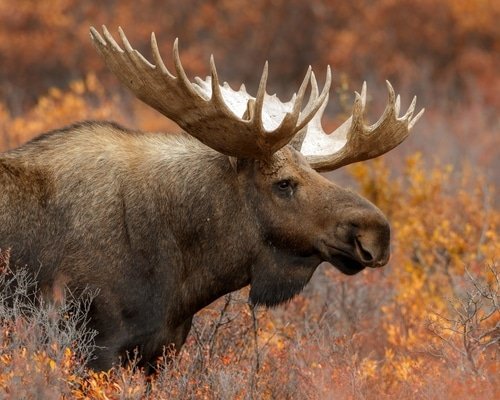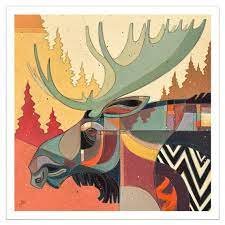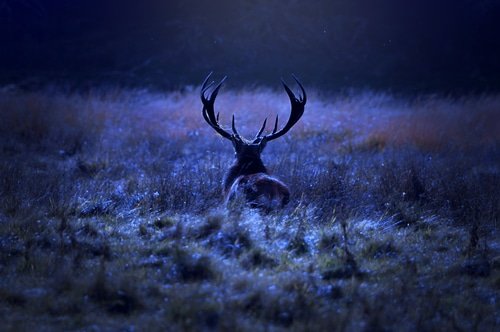Majestic and awe-inspiring, the moose stands tall as the largest member of the deer family. This magnificent creature has captivated nature enthusiasts worldwide with its imposing size and distinct features. Found in various regions across North America, Europe, and Asia, moose are known for their unique characteristics that set them apart from other members of the animal kingdom. Let’s get into more moose facts for your education.
Moose is the Largest Member of the Deer Family
When we talk about size, there is no surpassing the moose. These gentle giants can reach towering heights, with adult males often standing around 6 to 7 feet at their shoulders and weighing up to 1,500 pounds.
As for their overall length, including those mighty antlers they proudly carry on their heads, they can measure up to an impressive 10 feet. Compared to these males, female moose are slightly smaller but still quite substantial.
Fun Fact: Moose Are Known for Their Distinctive Antlers
One cannot discuss moose without mentioning their iconic antlers. These magnificent appendages are a sight to behold! From early spring each year, male moose begin growing a fresh set of antlers covered in velvet—a soft tissue that nourishes this rapid growth phase.
The shape and size of antlers vary depending on age and nutrition levels but can span up to six feet wide! And here’s another interesting tidbit: these antlers serve multiple purposes for male moose; not only do they make a striking visual statement during mating season, but they also aid them in defending territory or asserting dominance among rival bulls.
With just a glimpse into these impressive creatures’ introduction and noteworthy characteristics under our belt, prepare yourself for even more fascinating details about moose as we explore various aspects of their lives and existence. So, let’s dive deeper into the world of these gentle giants and uncover some interesting moose information and fun moose trivia along the way.
Moose Habitat and Distribution
Description of Moose Habitats
When it comes to habitats, moose are quite adaptable creatures. They wander through various landscapes, from dense forests to expansive wetlands and even the tundra regions. These magnificent animals have managed to carve out a niche in each environment.
In the forested areas, moose rely on the cover provided by the towering trees and browse on leaves, twigs, and bark. Wetlands offer them easy access to their preferred aquatic vegetation, which they relish munching on with great delight.
And can you believe it? These majestic beings also inhabit the frigid tundra regions, using their long legs to navigate through deep snow for food.
Interesting Detail: Moose Distribution
Here’s a fun moose trivia: These gentle giants are not restricted to just one continent! Nope!
They’re found in North America, Europe, and Asia. In North America, you’ll come across moose roaming freely in places like Canada and parts of Alaska (make sure you dress warmly if you plan on visiting).
Over in Europe, countries such as Sweden, Norway, Finland, and Russia provide suitable habitats for these magnificent creatures. And let’s not forget about Asia!
Countries like Mongolia and even parts of China play host to thriving moose populations. It’s truly amazing how widespread these beautiful beasts are!
So there you have it—moose habitat and distribution! These fascinating animals can be found frolicking amid forests’ verdant foliage or traversing icy tundras with grace.
Their adaptability knows no bounds as they explore landscapes across continents. Stay tuned for more interesting moose information coming your way!

Physical Characteristics of Moose
Size and weight comparison: Male moose (bulls) are larger than females (cows)
When it comes to the world of moose, size does matter. The males, known as bulls, are like the heavyweight champions of the forest. Picture this: a fully grown bull moose can reach a towering height of up to 6.5 feet at the shoulder!
That’s like having a basketball player stroll through the woods on stilts. And we’re not just talking about height here; these majestic creatures can tip the scales at an astonishing 1,500 pounds!
In comparison, female moose, or cows as they’re called, are comparatively petite and weigh around 800 to 1,200 pounds. It’s a classic “big brother” syndrome in the animal kingdom!
Fascinating fact: Moose have long legs adapted for walking through deep snow
If you’ve ever wondered how these magnificent creatures navigate through snowy landscapes gracefully and easily, it all comes down to their remarkable anatomy. Moose have developed a game-changing adaptation: their long legs! These seemingly never-ending appendages let them traverse the deepest snow cover without sweat.
Imagine strapping on snowshoes custom-made for giants – that’s what moose do every winter. It’s like they were gifted with nature’s version of stilts!
Thanks to this incredible adaptation, moose can access food sources hidden beneath layers of powdery snow that would be off-limits to many other animals. So next time you find yourself knee-deep in snow during winter, think of those marvelous moose trotting along with their elongated legs and be grateful for your shorter human stride!
Antlers and Their Growth
The Magnificent Antlers of Moose
When it comes to fascinating moose facts, their antlers steal the show. These majestic creatures boast some of the most impressive headgear in the animal kingdom.
The growth process of moose antlers is truly remarkable. Each spring, male moose grow a new set of antlers from bony structures called pedicles on their skulls.
The growth is incredibly rapid, with antlers gaining up to an inch per day! It’s like Mother Nature’s version of a supercharged growth spurt.
Male Moose: The Annual Antler Shedders
Here’s the intriguing part: while many animals keep their antlers throughout their lives, male moose have an annual shedding party! Once winter sets in and mating season ends, these dapper gentlemen bid farewell to their glorious antlers. It might initially seem odd, but there’s a reason behind this unusual behavior.
Shedding their antlers helps conserve energy during the harsh winter when food is scarce. Plus, it gives them a fresh start for regrowth come springtime.
So next time you spot a majestic moose sporting its splendid rack of antlers, take a moment to appreciate the intricate growth process these amazing creatures go through each year. It’s just another example of nature’s ingenuity and a testament to the wonders that await us when exploring the wild world of moose.
Diet and Feeding Habits
Overview of Moose Diet: Herbivores with a Greens-Only Policy
When it comes to dining habits, moose are strictly herbivores. These magnificent creatures have a greens-only policy, munching their way through various plant-based delights.
The moose diet includes tasty treats like twigs, leaves, and aquatic vegetation. When lush foliage is abundant in the summer, moose quench their appetites by feasting on tender green leaves and shoots.
During the colder seasons, when leafy greens become scarce, these resourceful creatures turn to the hardy twigs and buds they can still reach beneath the snow. It’s fascinating how they adapt their diet throughout the year!
Intriguing Tidbit: Moose Have an Insatiable Appetite
Here’s some fun moose trivia: these impressive animals have an insatiable appetite! To fuel their massive bodies, moose can consume up to 60 pounds of food daily! That’s equivalent to devouring roughly two human-sized sacks of potatoes!
With such voracious eating habits, it’s no wonder why moose spend a significant portion of their waking hours browsing for tasty vegetation. Whether munching on scrumptious aquatic plants in shallow ponds or reaching high into the trees for mouth-watering branches, these herbivorous giants know how to satisfy their hunger.
By indulging in such generous portions daily, moose maintain their strength and stamina while ensuring they have enough energy reserves during harsh winters when food becomes scarce. It’s truly remarkable how much sustenance these majestic creatures require to thrive in their natural environment.
So next time you stumble across a mighty moose grazing by a tranquil pond or nibbling on twigs along a forest path, take a moment to appreciate their remarkable diet and insatiable appetite. Yet another fascinating aspect of these incredible animals makes them a true wonder of the natural world.
Social Behavior and Communication
Insight into Moose Social Structure within Small Family Groups
Moose are fascinating creatures not only for their impressive size but also for their unique social behavior. These majestic animals exhibit a complex social structure, primarily centered around small family groups.
Within these groups, known as cow-calf pairs, a female moose, a cow, will typically be accompanied by her offspring from the previous year. This close-knit family unit protects and supports the young as they navigate the wilderness challenges.
The hierarchy within moose social groups is apparent during mating season when bulls engage in competitive behavior to establish dominance. The dominant bull earns the right to mate with receptive cows in the area, ensuring his genes are passed on to future generations.
While this might sound like a cutthroat competition, it’s important to note that this behavior is restricted to the breeding season. Outside this period, moose generally exhibit peaceful interactions within their family units.
Lesser-Known Fact: Bulls Use Vocalizations like Grunts and Bellows During Mating Season
When it comes to romance in the moose world, bulls have a unique way of expressing their intentions. During mating season, male moose use vocalizations such as grunts and bellows to communicate with cows and rival bulls. These deep sounds reverberate through forests and can carry over long distances.
The grunts emitted by bulls indicate dominance and help establish territory boundaries during mating rituals. They are often accompanied by thrashing antlers against trees or shrubs as an intimidating display towards other males vying for attention from fertile females.
In addition to grunts, bull moose produce resonant bellows that echo through the woods. These distinctive calls attract interested cows while warning rival suitors of their presence.
The hauntingly beautiful sound of a moose bellowing in the distance is a testament to their unique communication abilities during this captivating time of year. Understanding moose’s social behavior and communication patterns adds to the intrigue and awe surrounding these magnificent creatures.
It reminds us that they possess physical grandeur and exhibit intricate social dynamics. So, next time you find yourself in moose-inhabited regions, keep an ear out for their vocalizations; it’s nature’s way of orchestrating the enchanting dance of love and survival.
Reproduction and Life Cycle
Mating Rituals: A Dance in the Wilderness
When it comes to romance, moose have their unique way of wooing their mates. During the mating season, which typically occurs in the fall, male moose put on quite a show to win over the ladies. They engage in fierce battles with other males, clashing their mighty antlers like swords of nature.
These battles determine dominance and establish a hierarchy among the males, allowing the strongest and most vigorous bull moose to find favor with the females. Once a male has successfully triumphed over his competitors, he gains access to a group of females known as a harem.
He will then court these lovely ladies by performing an elegant display of head-tossing, thrashing vegetation with his massive antlers, and emitting deep grunts that echo through the forest. It’s a dance in the wilderness that showcases strength, agility, and charisma.
The Miracle of Moose Calving: A Springtime Delight
After all those romantic endeavors, it’s time for motherhood in the moose kingdom. Female moose or cows carry their offspring for about eight months before giving birth — an impressive feat!
Typically occurring each spring when nature begins to awaken from its slumber, these gentle giants bring new life into the world. Female moose usually birth one or two adorable calves at a time.
These little ones are born with long legs, ready to explore their surroundings from day one. It’s heartwarming to witness mother and calf bonding so strongly; they form an unbreakable connection as they navigate together through forests and meadows.
The arrival of moose calves is delightful and essential for sustaining healthy populations. With each new generation joining these majestic creatures roaming our lands, we can appreciate how vital it is to protect their habitats and ensure their continued survival.
Moose reproduction is truly a marvel of nature, reminding us of the wonders that unfold within the vast tapestry of life. Remember, when you stumble upon fun moose trivia or interesting moose information like this, take a moment to appreciate the intricacies of the animal kingdom and its breathtaking diversity.
Moose Predators and Threats
The Wild Hunt: Wolves and Bears
When it comes to the predator-prey dynamics in the wild, moose have their fair share of adversaries. Two of the most formidable foes are none other than wolves and bears.
These majestic creatures, equipped with their hunting prowess, constantly threaten moose populations. Packs of wolves work together, utilizing their strategic tactics to bring down these massive herbivores.
Similarly, bears, especially grizzlies, are known for their strength and tenacity when hunting moose. The thrilling battle between the predators and their prey serves as a reminder of nature’s unyielding balance.
Tiny Terrors: Ticks
While it may sound peculiar, ticks can become a significant concern for moose populations in certain areas. These tiny parasites latch onto unsuspecting moose as they venture through forests or wetlands. Not only do ticks cause discomfort and irritation for these gentle giants, but they also transmit diseases that can severely affect their health.
Moose can be heavily infested with ticks during the warmer months when these bloodthirsty arachnids thrive. This interesting twist reveals how even the smallest creatures can threaten these magnificent animals significantly.
While wolves and bears symbolize the classic predators that challenge moose survival in the wild, it is intriguing and surprising to discover that ticks also pose threats to these magnificent creatures’ well-being. Understanding these various dangers allows us to appreciate the delicate balance between predator and prey in nature’s intricate web of life.
Conservation Status
When it comes to the conservation status of moose, we have some good news and some not-so-good news. In North America, moose populations are generally stable, although specific regions have experienced declines due to factors such as habitat loss and climate change.
In Europe and Asia, however, several subspecies of moose are classified as endangered or vulnerable. Efforts are being made to protect these magnificent creatures and their habitats.
Conservation organizations work tirelessly to ensure the preservation of suitable environments for moose populations to thrive. Land management practices, wildlife corridors, and addressing climate change impacts are crucial in safeguarding these iconic forest giants.
Conclusion
Throughout this article filled with fun moose trivia and interesting moose information, we’ve delved into the world of these majestic animals. The moose stands out in the animal kingdom, from their impressive antlers that captivate our attention to their unique behaviors that reveal their social dynamics.
While challenges exist in maintaining healthy population numbers for certain subspecies, there is hope. The efforts put forth by conservationists worldwide aim to ensure a brighter future for these gentle giants that grace our forests.
So, let us continue to appreciate and admire these incredible creatures while working together towards their conservation. By doing so, we can make sure future generations will also be able to witness the awe-inspiring sight of a mighty moose roaming freely through its natural habitat.



